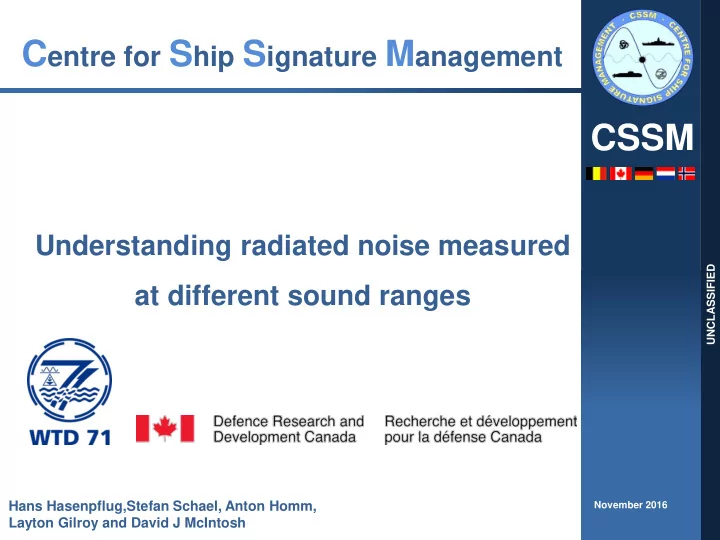

C entre for S hip S ignature M anagement CSSM Understanding radiated noise measured UNCLASSIFIED at different sound ranges Hans Hasenpflug,Stefan Schael, Anton Homm, November 2016 Layton Gilroy and David J McIntosh
Backgound The acoustic signature is an essential factor for the operational capabilities of naval platforms (submarines) Acoustic signature requirements have to be UNCLASSIFIED fulfilled and verified during the full life time Valid and reliable measurements are mandatory The acoustic signature of two naval research vessels was measured at different sound ranges and analyzed in order to identify range dependent differences 2 2
RIMPASSE Radar Infra-red electro-Magnetic Pressure Acoustic Ship Signature Exepriments UNCLASSIFIED 3
Content Main influences Platforms Trials Sound ranges UNCLASSIFIED Comparison of static trials Comparison underway trials Summary 4
Main influences Range geometry (underwater sensor layout) Passing distance (CPA) Propagation (bottom properties) UNCLASSIFIED Background noise Stability of the noise source (Platform) Used methodology for calculating average noise levels 5
Main influences Acoustic centre Range geometry & hydrophone layout Sound Range Planet Quest (27 m) (12 m) Possible differences due to: Location acoustic centre Aschau 3.1 1.0 Hydrophone layout Loch Goil 0.9 0.4 Possible error (dB) 2.2 0.7 UNCLASSIFIED Lloyd’s Mirror 6 6
Platforms (sources) Quest Planet Monohull concept with DC Swath concept with PM propulsion UNCLASSIFIED propulsion 2200 ton / 76 m / 12.5 m 3850 ton/ 73 m / 27 m Damping tiles DG set double mounted DG sets on common and enclosed located above waterline enclosed raft 7
Platforms (sources) Onboard sensors: Structure borne noise was measured simultaneously during all trials Sensors mounted at hull frames, main machinery and machinery foundations UNCLASSIFIED 8
Trials Static trials Platform moored between buoys Aschau 2 and Loch Goil Determine noise levels of individual (auxiliary) machinery and ship foundation transfer functions UNCLASSIFIED Underway (dynamic) trials Platform sails on dedicated track Loch Fyne, Heggernes, Aschau 1 and 2 Determine the overall underwater noise levels as function of speed and platform configuration (6, 9 and 12 kts) 9
Sound ranges Loch Goil Loch Fyne Heggernes Aschau UNCLASSIFIED 10
Comparison results static trials Individual DG-sets of Planet Higher levels at Aschau caused by range geometry and hydrophone layout Average delta is small taking in UNCLASSIFIED account Lloyd Mirror’s 11
Comparison results underway trials Methodology: Platform position was determined with DGPS Acoustic measurement were carried out in Port, Stbd and Keel aspect 1/3-octave band spectra were calculated for each second segment of the time series data UNCLASSIFIED Average Port and Stbd side noise levels were calculated when the platform was at CPA within +/- 20 ° arc Spherical propagation loss for distance corrections (20 log R) was applied 1000 m Steady state condition 200 m Repetitions for each configuration were requested 20 ° 12
Planet 6 kts @ Aschau 1 Repetition is mandatory Each frequency band was inspected within a recorded time window Recordings with high UNCLASSIFIED deviation behavior were skipped 13 13
Planet 6 kts @ Aschau 2 Larger deviation than MP 1 Only 3 of 7 runs were valid More helm activity during the recording due to the UNCLASSIFIED physical range limits 14 14
Planet 6 kts @ LF CPA at Loch Fyne and Heggernes > 100 m Impact of background noise Low background noise levels are required in order to have sufficient signal to noise UNCLASSIFIED Different results due to ambient conditions 15
Comparison results underway trials Planet 6 kts Ambient noise UNCLASSIFIED Bottom effect Distance Correction Δ ~ 2 dB Lloyd’s Mirror 16
Comparison results underway trail Planet 12 kts UNCLASSIFIED Bottom effect Propeller cavitation Lloyd’s Mirror 17
Correlation onboard & off-board measurements Significant higher underwater noise levels at Loch Fyne and Heggernes Identified underwater differences correlation with structure borne noise near the propellers Acoustic monitoring yields UW UNCLASSIFIED Accelerometers at thrust bearing acoustic estimation off-board onboard 18
Quest 6 kn range comparison Comparable results at Loch Fyne and Heggernes At Aschau substantial higher results due to contribution of diesel noise Good correlation found between off- board and onboard measurements UNCLASSIFIED 19
Overall results UNCLASSIFIED Taking in account all range and platform effects Delta < 3 dB 20
Summary The difference in the radiated underwater sound can be explained by the different hydrophone configurations Deviations within an acceptable margin (delta < 3 dB) Background noise and partial inconsistencies of both vessels as noise sources limit the range comparison UNCLASSIFIED Signature components changed across sound ranges (Machinery sound short and Cavitation behavior) Very good correlation can be observed between the underwater noise results and the on-board structure borne sound measurements (acoustic monitoring is feasible) 21
Acknowledgements RIMPASSE was an excellent international cooperative measurement trial resulting in a unique signature dataset Germany (WTD71) and Canada (DRDC) made available two naval research vessels, Planet and Quest, respectively In a time frame of 6 weeks, acoustic measurements were carried out UNCLASSIFIED at different locations by QinetiQ, WTD71, DST Group, TNO, DMO, DGA and FFI. Results are used for feasibility studies on the development of a signature management system (COSIMAR) and several range comparison studies 22
QUEST-IONS UNCLASSIFIED 23
Recommend
More recommend